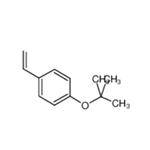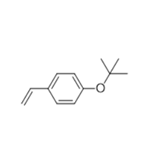4-tert-butoxystyrene is a pendant functionalized styrene that structurally, It is similar to PMOS, both carrying an alkoxyl p-substituent, whose electron-donating and resonance effects allow them to be'polymerized by cationic, anionic, and radical mechanisms. It is used to treatment of its polymers with an acid leads to poly(4-vinylphenol), which finds a wide variety of applications to photoresists, epoxy-curing agents, adhesives, etc.).
Colorless to Almost colorless clear liquid.
4-tert-Butoxystyrene is used in organic synthesis. It is used to synthesize 4'-tert-butoxy-biphenyl-4-carboxylic acid methyl ester.
4-tert-Butoxystyrene is an organic synthetic reagent used as a polymer monomer in the preparation of poly(4-tert-butoxystyrene) (PtBSt) and other living polymers. Poly(4-tert-Butoxystyrene) is a new hexane-soluble polymer surfactant that can be used to form micelles.
Preparation of 4-tert-Butoxystyrene (3-tert-Butoxystyrene). To a 2000-mL three-necked round-bottom flask equipped with a dropping funnel, thermometer, reflux condenser, paddle stirrer and nitrogen inlet were placed 19.4 g (0.80 mol) of magnesium turnings and enough freshly dried and distilled tetrahydrofuran (THF) to cover the turnings. There were then added dropwise with stirring a solution of 143.3g (0.78 mol) of freshly distilled 4-bromostyrene (bp 46-47°C (0.03 mm)) in 500mL of THF. After 20mL of the 4-bromostyrene had been added, an exothermic reaction set in and was maintained between 25 and 35°C by adjusting the rate of addition of the bromo compound and with the aid of an ice bath. After the addition had been completed, the reaction mixture was heated to 60°C for 0.5h. Using a NaC1-ice bath, the mixture was cooled to 0°C and a solution of 100.88g (0.52 mol) of tert-butyl peroxybenzoate in 200 mL of THF was added via the dropping funnel at such a rate that the reaction temperature was maintained between 0 and 5°C. After completion of the addition, the reaction mixture was stirred at 25°C for 2 h. The organic layer was separated from the solid magnesium benzoate by decantation and the volume of the solution reduced on a rotary evaporator. The yellow oil that remained was washed with 1000 mL of 3% aqueous HCl solution and the organic layer separated. The aqueous layer was washed with two 200-mL portions of ether, and the ether and organic layers were combined and together washed with two 75-mL portions of a 10% NaOH solution followed by washing with water until the aqueous washings were neutral. After the solution was dried over Na2S04 and the ether was removed via a rotary evaporator, the remaining pale yellow oil was purified by fractional distillation in the presence of a few milligrams of ionol (2,6-ditert-butyl-4-methylphenol) as an inhibitor. There were obtained 46 g (50% yield, bp 45°C (0.02 mm)) of 4-tert-Butoxystyrene having the following elemental analysis.
Living cationic sequential block copolymerization of isobutylene with 4-tert-butoxystyrene: synthesis and characterization of poly(p-hydroxystyrene-b-isobutylene-b-p-hydroxystyrene) triblock copolymers.
Bouchékif, H.; Som, A.; Sipos, L.; Faust, R.; Journal of Macromolecular Science, Part A: Pure and Applied Chemistry (2007), 44(4), 359-366.



